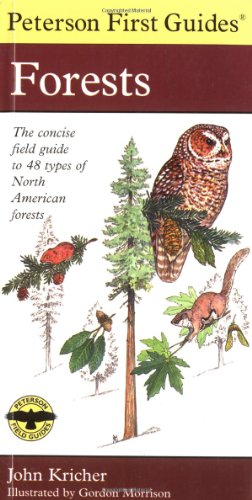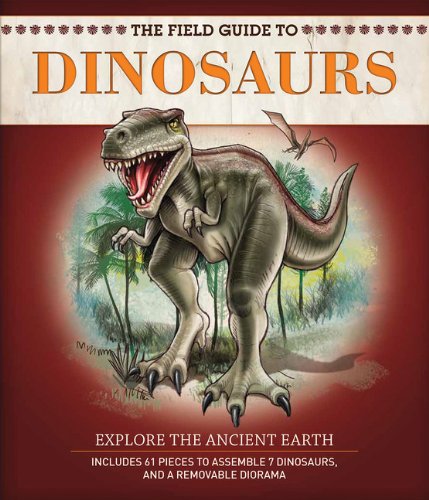-
The Field Guide to Rainforest Animals: Explore the Amazon Jungle
Nancy Honovich
Flexibound (Silver Dolphin Books, May 5, 2015)Join the adventure of a lifetime as you explore the Amazon Rain Forest! Follow the trail of the jungle's most magnificent creatures, including silent jaguars, leaping monkeys, and pink river dolphins in The Field Guide to Rain Forest Animals. Learn the difference between New World and Old World monkeys, how to detect the presence of a Dwarf Caiman crocodile, and why Vampire Bats can walk and run. This unique interactive journal is filled with photographs, maps, and detailed illustrations of eight interesting jungle animals. At the end of this book kids can continue the adventure by assembling their animals amidst a colorful diorama for their own museum-ready display! L
L
-
The Field Guide to Dinosaurs
Nancy Honovich, Ryan Hobson
Hardcover (Silver Dolphin Books, April 7, 2009)The Petrified Forest of Arizona seemed like the perfect place to start to search for fossils,” writes our hero in his 1929 journal. Thus begins the exciting hunt for dinosaurs and their prehistoric secrets in The Field Guide to Dinosaurs. Through a series of journal entries, kids will uncover the mysteries of the dinosaur kingdomfrom the speedy and agile Coelophysis to the existence of Pangaea, the landmass of the earth some 227 million years ago when all of the continents were one. Junior paleontologists can experience the excitement of a dig as they rifle through maps, illustrations, and build eight dinosaur models and a museum-ready diorama. Dino-crazy kids ages 8 and up will dig this lively adventure! N
N
-
The Field Guide to Safari Animals
Paul Beck, Ryan Hobson
Hardcover (Silver Dolphin Books, July 28, 2008)Young explorers embark on the safari adventure of a lifetime with this fabulous faux-journal, written” in 1924 by fictional naturalist Rebecca Mayhew. Through her journal entries, youngsters accompany Mayhew as she explores mysterious Africa, from tracking lions in Nairobi to watching white rhinos in Pretoria to marveling at the birth of a baby giraffe in Botswana. Each info-packed page is filled with stunning photographs, colorful maps and illustrations, and fascinating facts about African animals and their environment. At the journey’s end, children can assemble the eight animals from 59 included die-cut pieces and then display them on a gorgeous, removable 3-D diorama. R
R
-
Peterson First Guide to Astronomy
Jay M. Pasachoff Professor of Astronomy, Roger Tory Peterson
Paperback (Houghton Mifflin Harcourt, )None S
S
-
The Field Guide to Ocean Animals
Phyllis Perry, Roger Hall, Ryan Hobson
Flexibound (Silver Dolphin Books, July 29, 2014)With this interactive book, young readers embark on an underwater adventure exploring the Great Barrier Reef! Follow the trail of the ocean's most magnificent creatures, including the powerful gray reef shark, the graceful-yet-deadly man-of-war, and the paralyzing blue-ringed octopus. Join marine biologist Warren Wilmott on his expedition and learn why the sea wasp is one of the deadliest creatures swimming in our oceans today and why red lionfish sometimes swims upside down. Filled with incredible animal photographs, maps, interesting information, and detailed illustrations, The Field Guide to Ocean Animals transports budding biologists to another world! The adventure continues as readers assemble seven different animals stored inside the pockets of each page and set up the included diorama for a stunning display. O
O
-
The Field Guide to Insects: Explore the Cloud Forests
Paul Beck, Ryan Hobson
Hardcover (Silver Dolphin Books, May 25, 2010)"This evening at dusk we went on a beetle hunt . . . there were jewel scarabs, gems of the cloud forest. Some shone like polished gold, silver and bronze," writes fictional scientist Randall Barnes in his 1926 field journal. Barnes takes kids on an amazing adventure through Central America, as he studies some of the most beautiful and fascinating insects on the planet, including stunning blue morpho butterflies, battling Hercules beetles, and bizarre walking sticks. The sixth title in a phenomenally successful series, The Field Guide to Insects is designed to look like an authentic antique journal, filled with interesting maps, sketches, and engaging field notes. Kids will especially enjoy the book's interactive elements, which include eight exotic insects to assemble and a punch-out diorama. Extreme fun for future explorers, ages eight and up. O
O
-
Field Guide to the Insects of America North of Mexico
Donald Joyce Borror
Hardcover (Houghton Mifflin (T), Sept. 15, 1973)Find what you're looking for with Peterson Field Guidesâtheir field-tested visual identification system is designed to help you differentiate thousands of unique species accurately every time. Â Detailed descriptions of insect orders, families, and many individual species are illustrated with 1,300 drawings and 142 superb color paintings. Illustrations - which use the unique Peterson Identification System to distinguish one insect from another - include size lines to show the actual length of each insect. A helpful glossary explains the technical terms of insect anatomy.
-
Peterson First Guide to Seashores
Roger Tory Peterson, John C. Kricher, Gordon Morrison
Paperback (Houghton Mifflin Harcourt, May 15, 1998)This complete guide covers 317 of the most common and conspicuous plants and animals of the seashores, from jellyfish and kelp to clams, gulls, and whales. Species are grouped by habitat so readers know what they can expect to see along sandy beaches, in rocky tide pools, or in mud flats. S
S
-
Field Guide to the Larger Mammals of Africa
Chris & Mathilde Stuart, Chris Stuart
Paperback (Random House Struik, Sept. 1, 2007)Of the world's 4,000 to 4,500 mammal species, about 1,100 occur in Africa. In this updated and revised edition of Field Guide to the Larger Mammals of Africa, authors Chris and Tilde Stuart concentrate on the more visible and easily distinguished larger mammal species, plus some of the more frequently seen smaller mammals. In all, over 400 color photographs, combined with concise, pertinent information highlighting the diagnostic features of each species, provide a comprehensive source of information on each mammal. The latest information has been incorporated and the distribution maps have been revised to reflect the most up-to-date habitat and distribution patterns for each species. A new feature is the inclusion of the mammals' skulls, grouped together at the back of the book. To aid the reader, color-coding and symbols indicating the habitat and activity period serve as a quick reference to the various mammal groups.
-
Peterson First Guide to Forests
John C. Kricher, Roger Tory Peterson, Gordon Morrison
Paperback (Houghton Mifflin Harcourt, )None
-
The Field Guide to Birds: Explore Southern Asia and Oceania
Nancy Honovich, Ryan Hobson
Hardcover (Silver Dolphin Books, April 12, 2011)Written as the research notebook of a 1920s naturalist who's just completed an expedition to Vietnam, India, Australia, and other countries, The Field Guide to Birds offers kids an in-depth look at the remarkable creatures that fly through the skies of these lands, as well as a hands-on experience with eight exotic birds to assemble. They'll learn how the north island brown kiwi finds food in the dark (even though it has very small eyes), and how the green peacock targets a poisonous coral snake for a snack. They'll also learn where to find the black kite, the Wilson's bird of paradise, and other remarkable birds.The lands of southern Asia and Oceania are home to some of the world's most beautiful and strange birds. There's the greater flamingo, whose color is determined by its diet, and the golden bowerbird, who croaks like a bullfrog. They're not like the birds kids see in their own backyards or keep in cages in their living rooms—but with The Field Guide to Birds, they'll get to know them just as well!With the pieces to assemble eight exotic birds themselves, The Field Guide to Birds also provides kids with a unique, hands-on experience. By following the simple instructions and placing their birds in the removable diorama, they'll become at-home explorers, getting closer than ever before to seeing these wild creatures in their natural habitats.The Field Guide to Birds takes kids on the adventure of a lifetime—without leaving home! O
O
-
The Field Guide to Dinosaurs
Nancy Honovich
Flexibound (Silver Dolphin Books, Aug. 26, 2014)The Petrified Forest of Arizona seemed like the perfect place to start to search for fossils,” writes our hero in his 1929 journal. Thus begins the exciting hunt for dinosaurs and their prehistoric secrets in The Field Guide to Dinosaurs. Through a series of journal entries, readers uncover the mysteries of the dinosaur kingdom from the speedy and agile Coelophysis to the existence of Pangaea, the landmass of some 227 million years ago when all of the continents were one. Junior paleontologists can experience the excitement of a dig as they rifle through maps, illustrations, and engaging interactive elements, including seven dinosaur models and a museum-ready diorama that they can easily assemble themselves. N
N